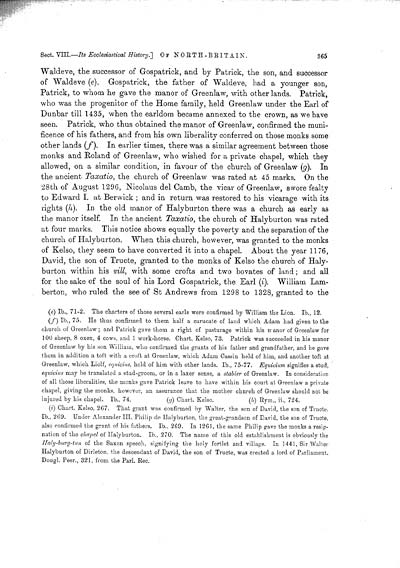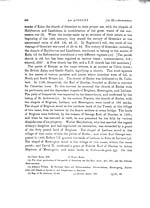Volume 3
(377) Page 365
Download files
Individual page:
Thumbnail gallery: Grid view | List view

365 Waldeve, the successor of Gospatrick, and by Patrick, the son, and successor of Waldeve (e). Gospatrick, the father of Waldeve, had a younger son, Patrick, to whom he gave the manor of Greenlaw, with other lands. Patrick, who was the progenitor of the Home family, held Greenlaw under the Earl of Dunbar till 1435, when the earldom became annexed to the crown, as we have seen. Patrick, who thus obtained the manor of Greenlaw, confirmed the muni- ficence of his fathers, and from his own liberality conferred on those monks some other lands (f). In earlier times, there was a similar agreement between those monks and Roland of Greenlaw, who wished for a private chapel, which they allowed, on a similar condition, in favour of the church of Greenlaw (g). In the ancient Taxatio, the church of Greenlaw was rated at 45 marks. On the 28th of August 1296, Nicolaus del Camb, the vicar of Greenlaw, swore fealty to Edward I. at Berwick ; and in return was restored to his vicarage with its rights (h). In the old manor of Halyburton there was a church as early as the manor itself. In the ancient Taxatio, the church of Halyburton was rated at four marks. This notice shows equally the poverty and the separation of the church of Halyburton. When this church, however, was granted to the monks of Kelso, they seem to have converted it into a chapel. About the year 1176, David, the son of Tructe, granted to the monks of Kelso the church of Haly- burton within his vil, with some crofts and two bovates of land; and all for the sake of the soul of his Lord Gospatrick, the Earl (i). William Lam- berton, who ruled the see of St Andrews from 1298 to 1328, granted to the (e) Ib., 71-2. The charters of those several earls were confirmed by William the Lion. Ib., 12. (f) Ib., 75. He thus confirmed to them half a carucate of land which Adam had given to the church of Greenlaw; and Patrick gave them a right of pasturage within his manor of Greenlaw for 100 sheep, 8 oxen, 4 cows, and 1 work-horse. Chart. Kelso, 73. Patrick was succeeded in his manor of Greenlaw by his son William, who confirmed the grants of his father and grandfather, and he gave them in addition a toft with a croft at Greenlaw, which Adam Cassin held of him, and another toft at Greenlaw, which Liolf, equicius, held of him with other lands. Ib., 75-77. Equicium signifies a stud, equicius may be translated a stud-groom, or in a laxer sense, a stabler of Greenlaw. In consideration of all those liberalities, the monks gave Patrick leave to have within his court at Greenlaw a private chapel, giving the monks, however, an assurance that the mother chnrch of Greenlaw should not be injured by his chapel. Ib., 74. (g) Chart. Kelso. (h) Rym., ii., 724. (i) Chart. Kelso, 267. That grant was confirmed by Walter, the son of David, the son of Tructe. Ib., 269. Under Alexander III. Philip de Halyburton, the great-grandson of David, the son of Tructe, also confirmed the grant of his fathers. Ib., 269. In 1261, the same Philip gave the monks a resig- nation of the chapel of Halyburton. Ib., 270. The name of this old establishment is obviously the Haly-burg-tun of the Saxon speech, signifying the holy fortlet and village. In 1441, Sir Walter Halyburton of Dirleton, the descendant of David, the son of Tructe, was created a lord of Parliament. Dougl. Peer., 321, from the Parl. Rec.
Set display mode to:
![]() Universal Viewer |
Universal Viewer | ![]() Mirador |
Large image | Transcription
Mirador |
Large image | Transcription
Images and transcriptions on this page, including medium image downloads, may be used under the Creative Commons Attribution 4.0 International Licence unless otherwise stated. ![]()
| Caledonia, or, An account, historical and topographic of North Britain from the most ancient to the present times > Volume 3 > (377) Page 365 |
|---|
| Permanent URL | https://digital.nls.uk/74528828 |
|---|---|
| Description | Vol. III. |
|---|---|
| Attribution and copyright: |
|

